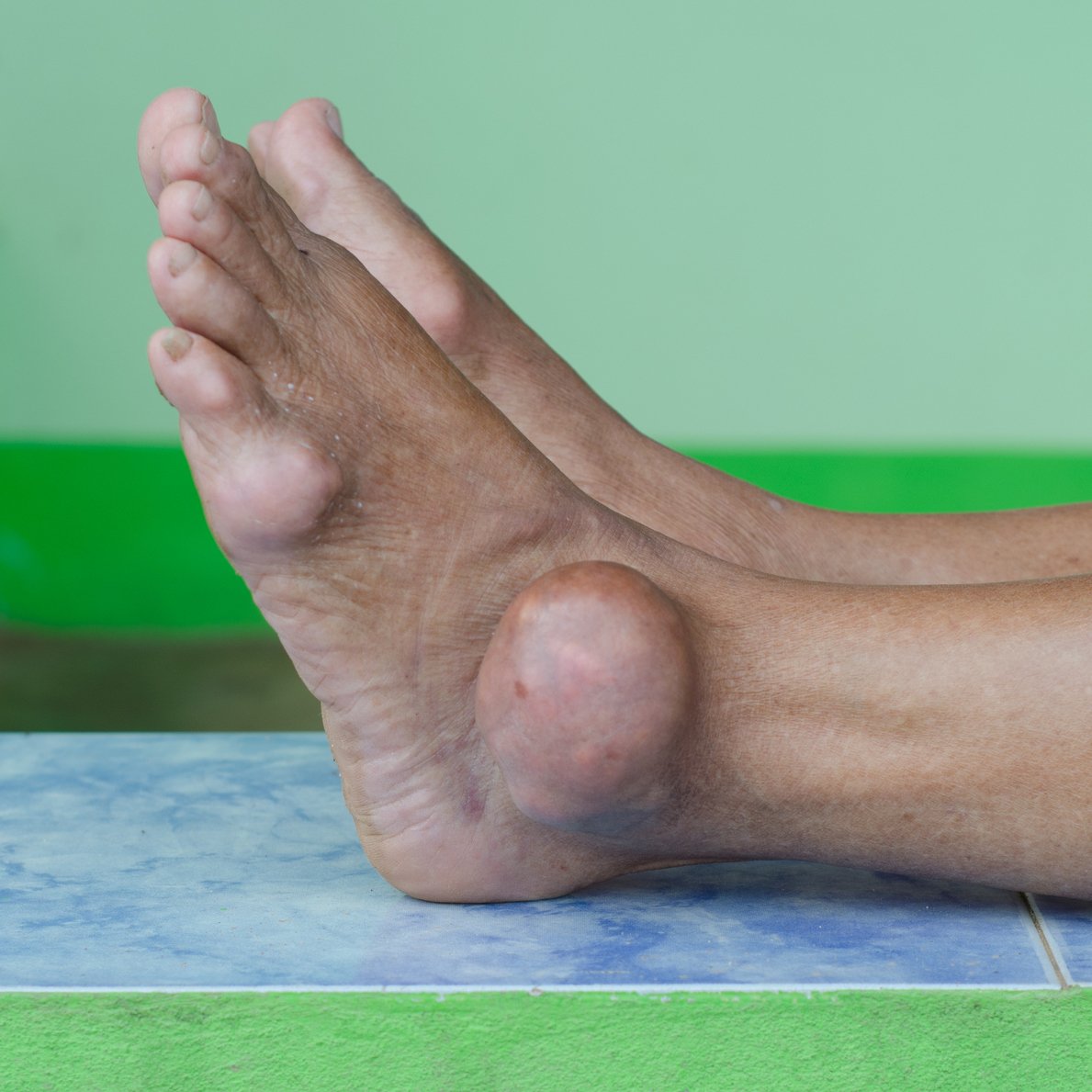WHAT WE TREAT
Gout
Gout is the most common type of inflammatory arthritis, affecting more than 8 million adults in the United States.
Unlike most types of arthritis, gout is characterized by periods of painful flares, followed by weeks to months with no symptoms.
This condition was once known as the “disease of the kings,” as it was commonly believed that gout was caused by an overindulgence of foods and wine that only the rich could afford. However, gout can affect anyone, and its prevalence has increased in the past two decades. Gout is more common in men (African American men are almost twice as likely to suffer from gout when compared to Caucasian men), women after menopause, and patients with kidney disease. It is uncommon in children.

What is Gout?
Gout is a rheumatic disease that results when there is a buildup of excess uric acid in the body. Uric acid is commonly found as a breakdown product of substances called purines, which are found in all tissues of the body, as well as in certain foods. Normally, uric acid dissolves in the blood, passes through the kidneys, and is excreted from the body in the form of urine. When the production of uric acid increases beyond the amount that the kidney can excrete, it is called hyperuricemia. Some patients with hyperuricemia do not develop gout; this is known as asymptomatic hyperuricemia and does not require treatment.
Increased levels of uric acid may also cause kidney stones, particularly if the excess uric acid ends up in the urinary tract.
There are four stages of gout. Asymptomatic tissue deposition occurs as gout first progresses, as increased uric acid levels begin to leave deposits of urate crystals (monosodium urate) within the joints and tissues. At this stage, patients do not present with any overt symptoms of gout, but the deposition of crystals begins to cause damage.
Acute flares is the second stage and is characterized by acute inflammation. Appearance of these urate crystals in the joints causes an immune reaction by white blood cells, leading to the painful episodes of gout that are seen in this stage, in addition to redness, swelling, and warmth around the affected area.
The next stage is known as intercritical segments, where the disease is clinically inactive following a painful attack. During this stage, patients continue to have hyperuricemia. After a first gout attack, the next attack may not occur for months, or even years. The longer that gout progresses, the shorter this third stage becomes.
The fourth stage of gout is chronic gout, or gouty arthritis, which is a degenerative form of chronic arthritis. Patients with chronic gout may also develop tophi, or lumps of urate crystals in the soft tissue beneath the skin.
Both acute and chronic gout can reduce quality of life, causing episodes of pain and discomfort. With proper treatment, this condition can be adequately managed, and patients with gout can lead normal lives.
What Causes Gout?
Gout is caused by an overproduction or underexcretion of uric acid in the body, which then causes the excess uric acid to collect and form needle-like urate crystals that settle within joints in the body.
Consumption of certain food and drinks may lead to an increase in the production of uric acid, thus causing gout to occur. Such items include:
-
Shellfish
-
Anchovies
-
Red meats
-
Dried beans
-
Peas
-
Alcohol (particularly when consumed in excess)
-
Sugary drinks
-
Foods that contain a high content of fructose
In addition to food and drink triggers, patients can develop gout when taking certain medications. Consult with your doctor if you are experiencing gout-like symptoms as a side effect of any of the medications listed below. It is not recommended that patients stop the use of any medication(s), unless cleared by their doctor.
-
Low-dose aspirin
-
Diuretics – hydrochlorothiazide (Esidrix, Hydro-D), Lasix
-
Immunosuppressants – Cyclosporine (Neoral, Sandimmune), Tacrolimus (Prograf)
-
Levodopa
-
Niacin (this is a vitamin)
Gout is also linked to certain medical conditions. Patients with the following health conditions are more likely to have acute or chronic episodes of gout:
-
Obesity
-
Hypertension
-
Hyperlipidemia
-
Diabetes
-
Recent organ transplant
Gout may also be genetically linked. Patients with family members who suffer from gout are more likely to have increased blood uric acid levels and develop gout. Patients who have an enzyme defect, which reduces the body’s ability to break down purines, are more likely to experience gout.
Patients with a history of gout may be at an increased risk for an acute attack if they sustain a constant high stress level, experience an overly stressful or traumatic event, or are exposed to lead chemicals.
Signs and Symptoms of Gout
The earliest and most common symptoms of gout attacks include intense pain and swelling in the joints. These attacks commonly occur at night. Gout is often diagnosed after a patient experiences intense pain and joint swelling for 1-2 nights, followed by a pain-free period, and then a similar painful episode with associated swelling of the joints. Other symptoms of gout may include redness, heat, and stiffness in the affected areas.
Gout can affect any joint, but most often occurs in the feet, particularly in the big toe. In fact, 50% of first-time gout attacks occur in the big toe. Other common joints that are affected by gout include the ankles, heels, knees, wrists, fingers, and elbows.
Gout may be accompanied by episodes of other types of arthritis that come and go with each attack. Because symptoms of gout are often similar to other types of arthritis, a definitive diagnosis of gout is indicated by the presence of urate crystals. These crystals can be found in the fluid within joints, and in deposits (tophi) that appear as lumps beneath the surface of the skin. The presence of tophi is often indicative of advanced or chronic gout.
Prevention of Gout
Avoiding possible triggers, such as overconsumption of certain foods and medications – particularly foods rich in purines – may help reduce the possibility of a gout attack.
Lifestyle changes such as maintaining a healthy weight, limiting alcohol intake, and consuming purine-rich foods such as meats and fish in moderation can help prevent and control gout. Drinking lots of water and exercising regularly is also recommended. While it is important to maintain a healthy weight, extreme weight loss may increase uric acid levels.
Patients with chronic gout may be prescribed long-term medications that help lower the level of uric acid in the blood to prevent or eliminate future gout attacks. Achieving blood uric acid levels less than 6 mg/dL is typically the goal of such preventative treatment.
Treatment of Gout
Treatment of gout varies depending on the patient. Factors such as kidney function, health conditions, patient preference, and severity of gout should be discussed with a medical provider to determine the best treatment plan. The goals for the treatment for gout are to reduce the pain of acute attacks, prevent the progression of chronic gout, limit the formation of tophi in the soft tissues, and prevent kidney stones from forming.
Minor or early episodes of gout typically resolve within 3-10 days, and sometimes clear up without treatment or further medical care.
Medications that can be used to treat acute gout attacks include:
-
Nonsteroidal anti-inflammatory drugs (NSAIDs)
-
Corticosteroids – prednisone
-
Colchicine – this medication works most effectively when taken within 12 hours of an episode of gout
In order to prevent future gout attacks, patients may also be prescribed small doses of NSAIDs, colchicine, or medications that lower the level of uric acid in the blood (allopurinol, febuxostat, pegloticase).
When Should I Call a Doctor?
You should consult a medical provider at the first signs of a gout attack. Even if the pain has subsided, uric acid buildup can continue to irritate your joints or lead to further, serious damage. Prescribed medications can help prevent or even reverse the buildup of uric acid, thus decreasing the likelihood of future gout attacks.
Call your doctor right away if you are experiencing any of the following symptoms:
-
Swollen and tender joints that are red and warm to the touch
-
Sudden, severe pain in a single joint
If this is a medical emergency, please call 911. For mental health emergencies, call 988.
Have a visit today
Virtual care is a convenient and secure way to receive medical care for gout by phone (where permitted) or video, 24/7/365.
